Mechanical Properties of Hybrid Fiber Reinforced Rubber Concrete
Abstract
:1. Introduction
2. Raw Materials and Test Methods
2.1. Raw Materials
2.2. Experimental Design
2.3. Sample Preparation
2.4. Data Processing
3. Experimental Results and Analysis
3.1. Experimental Result
3.2. Range Analysis
3.3. Variance Analysis
3.4. Analysis of Efficacy Coefficient
4. Analysis of SEM Micro
5. EDS Test
6. Strength Prediction Model
7. Conclusions
- The compressive strength, splitting tensile strength and flexural strength of HFRC are greater than those of ordinary concrete; the compressive strength is between 34.5–47.9 MP, the splitting tensile strength is between 4.72–6.63 MPa, and the flexural strength is between 7.05–8.98 MPa, indicating that basalt fiber and PVA fiber improve the strength of rubber concrete.
- The influence degree of the three factors on the compressive strength, splitting tensile strength and flexural strength of HFRC is VBF > VR > VPF. When VBF increased from 0.1% to 0.3%, the compressive strength, splitting tensile strength and flexural strength of HFRC increased by 25.85%, 23.59% and 16.31%, respectively.
- VBF is an extremely significant factor affecting the strength of HFRC; VPF has a certain impact on the compressive strength of HFRC and is an non-significant factor of the splitting tensile strength and flexural strength of HFRC; VR is a significant factor affecting the compressive strength of HFRC and it also has a certain impact on the splitting tensile strength and flexural strength of HFRC, but the impact on the flexural strength is greater than that on the splitting tensile strength.
- The hybrid of basalt fiber and PVA fiber showed a good synergy effect of fiber to enhance the strength of HFRC and reflected a good “positive hybrid effect” of fiber. In the studied HFRC in this paper, when the volume ratio of rubber is 5%, the increase in its strength has a certain effect, but when the volume ratio of rubber exceeds 5%, the strength of HFRC will show a negative growth effect.
- The best mix proportion combination is A3B2C1, that is, VBF is 0.3%, VPF is 0.2%, and VR is 5%. The bridging and reinforcement effect of fiber in HFRC was analyzed with the help of SEM microscopic and quantitative analysis of EDS. Finally, the strength of HFRC was predicted.
Author Contributions
Funding
Institutional Review Board Statement
Informed Consent Statement
Data Availability Statement
Conflicts of Interest
References
- Gaggiano, A.; Gambarelli, S.; Martinelli, E.; Nistico, N.; Pepe, M. Experimental characterization of the post-cracking response in hybrid steel/polypropylene fiber-reinforced concrete. Constr. Build. Mater. 2016, 125, 1035–1043. [Google Scholar] [CrossRef]
- Xargay, H.; Folino, P.; Sambataro, L.; Etse, G. Temperature effects on failure behavior of self-compacting high strength plain and fiber reinforced concrete. Constr. Build. Mater. 2018, 165, 723–734. [Google Scholar] [CrossRef]
- Arisoy, B.; Wu, H.-C. Experimental study of fatigue properties for partially short carbon fiber reinforced concrete. J. Exp. Mech. 2009, 24, 445–452. [Google Scholar]
- Su, D.Y.; Pang, J.Y.; Huang, X.W. Mechanical and dynamic properties of hybrid fiber reinforced fly-ash concrete. Adv. Civ. Eng. 2021, 2021, 3145936. [Google Scholar]
- Shao, J.W.; Zhu, H.; Xue, G.; Yu, Y.; Borito, S.M.; Jiang, W.L.X. Mechanical and restrained shrinkage behaviors of cement mortar incorporating waste tire rubber particles and expansive agent. Constr. Build. Mater. 2021, 296, 123742. [Google Scholar] [CrossRef]
- Thomas, B.S.; Kumar, S.; Mehra, P.; Gupta, R.C.; Joseph, M.; Csetenyi, L.J. Abrasion resistance of sustainable green concrete containing waste tire rubber particles. Constr. Build. Mater. 2016, 124, 906–909. [Google Scholar] [CrossRef] [Green Version]
- Yang, R.Z.; Xu, Y.; Wang, J. Experimental study on dynamic mechanics, energy characteristics, and failure mechanics of rubber cement mortar under SHPB splitting text. Mater. Rep. 2021, 35, 10062–10072. [Google Scholar]
- He, L.; Cai, H.D.; Huang, Y.; Ma, Y.; Van den Bergh, W.; Gaspar, L.; Valentin, J.; Vasiliev, Y.E.; Kowalski, K.J.; Zhang, J. Research on the properties of rubber concrete containing surface-modified rubber powders. J. Build. Eng. 2021, 35, 101991. [Google Scholar] [CrossRef]
- Liu, B.; Feng, M.; Lin, B.; Chai, Y.; He, W. Effects of Aggregate Types and Interface Improvements on Mechanical Properties of Crumb Rubber Concrete. China Railw. Sci. 2019, 40, 9–18. [Google Scholar]
- Chen, Z.; Li, L.; Xiong, Z. Investigation on the interfacial behaviour between the rubber-cement matrix of the rubberized concrete. J. Clean. Prod. 2019, 209, 1354–1364. [Google Scholar] [CrossRef]
- Liu, Y.S.; Pang, J.Y.; Yao, W.J. Fatigue performance of rubber concrete in hygrothermal environment. Adv. Mater. Sci. Eng. 2021, 2021, 9913297. [Google Scholar] [CrossRef]
- Zhang, J.T.; Yu, Z.P.; Sun, X.J.; Zhang, G.L.; Pan, W.G. Experimental study and failure mechanism analysis of rubber fiber concrete under the compression-shear combined action. Adv. Mater. Sci. Eng. 2021, 2021, 5554257. [Google Scholar] [CrossRef]
- Hu, Y.L.; Sun, X.W.; Ma, A.Q.; Gao, P.W.; Zhang, J.H. An experimental study on the basic mechanical properties and compression size effect of rubber concrete with different substitution rates. Adv. Civ. Eng. 2020, 2020, 8851187. [Google Scholar] [CrossRef]
- Ganjian, E.; Khorami, M.; Maghsoudi, A.A. Scrap-tyre-rubber replacement for aggregate and filler in concrete. Constr. Build. Mater. 2009, 23, 1828–1836. [Google Scholar] [CrossRef]
- Feng, L.Y.; Yuan, Q.; Ma, Y.; Shi, C.C. Experimental study on mechanical property of rubber concrete. J. Yangtze River Sci. Res. Inst. 2015, 32, 115–118. [Google Scholar]
- Ye, Y.X.; Wang, Z.B.; Xie, F.L.; Fu, C.H.; Zhang, Z.Y. Mechanical properties of steel fiber reinforced high-strength lightweight aggregate concrete. J. Build. Mater. 2021, 24, 63–70. [Google Scholar]
- Lee, J.H.; Cho, B.; Choi, E.; Kim, Y.H. Experimental study of the reinforcement effect of macro-type high strength polypropylene on the flexural capacity of concrete. Constr. Build. Mater. 2016, 126, 967–975. [Google Scholar] [CrossRef]
- Li, G.D.; Zhang, L.; Zhang, F.N.; Tang, J.Q. Acoustic emission characteristics and damage mechanisms investigation of basalt fiber concrete with recycled aggregate. Materials 2020, 13, 4009. [Google Scholar] [CrossRef]
- Li, Y.; Shan, A.Q.; Wu, H. Fractal dimension of basalt fiber reinforced concrete (BFRC) and its correlations to pore structure, strength and shrinkage. Materials 2020, 13, 3238. [Google Scholar] [CrossRef]
- Liu, F.Y.; Ding, W.Q.; Qiao, Y.F. Experimental investigation on the tensile behavior of hybrid steel-PVA fiber reinforced concrete containing fly ash and slag powder. Constr. Build. Mater. 2020, 241, 118000. [Google Scholar] [CrossRef]
- Ma, L.L.; Wang, B.; Zeng, L.; Xiao, Y.F.; Zhang, H.; Li, Z. Experimental investigation on the effect of rubber powder on mechanical properties of PVA fiber concrete. Adv. Civ. Eng. 2021, 2021, 6664416. [Google Scholar]
- Yao, Z.S.; Li, X.; Wu, T.L.; Yang, L.; Liu, X.H. Hybrid-fiber-reinforced concrete used in frozen shaft lining structure in coal mines. Materials 2019, 12, 3988. [Google Scholar] [CrossRef] [Green Version]
- Khan, M.; Cao, M.L.; Ali, M. Cracking behaviour and constitutive modelling of hybrid fibre reinforced concrete. J. Build. Eng. 2020, 30, 101272. [Google Scholar] [CrossRef]
- Huang, W.; Quan, W.; Ge, P. Orthogonal tests investigation into hybrid fiber-reinforce recycled aggregate concrete and convolutional neural network prediction. J. Asian Archit. Build. Eng. 2021. [Google Scholar] [CrossRef]
- Elias, N.; Wahab, R.; Jye, L.; Mahat, N.; Chandren, S.; Jamalis, J. Taguchi orthogonal design assisted immobilization of Candida rugosa lipase onto nanocellulose-silica reinforced polyethersulfone membrane: Physicochemical characterization and operational stability. Cellulose 2021, 28, 5669–5691. [Google Scholar] [CrossRef]
- Xu, X.Q.; Gu, Y.W.; Huang, W.; Chen, D.K.; Zhang, C.; Yang, X. Structural optimization of steel—epoxy asphalt pavement based on orthogonal design and GA—BP algorithm. Crystals 2021, 11, 417. [Google Scholar] [CrossRef]
- Wang, C.; Wang, A.L.; Zhang, X.S. Effect of dispersion of short carbon fibers on the mechanical properties of CFRC composites. Mater. Rep. 2007, 05, 125–128. [Google Scholar]
- He, S.Q.; Wang, H.C. Orthogonal experimental studies on mix design of high performance concrete. Ind. Constr. 2003, 33, 8–10. [Google Scholar]
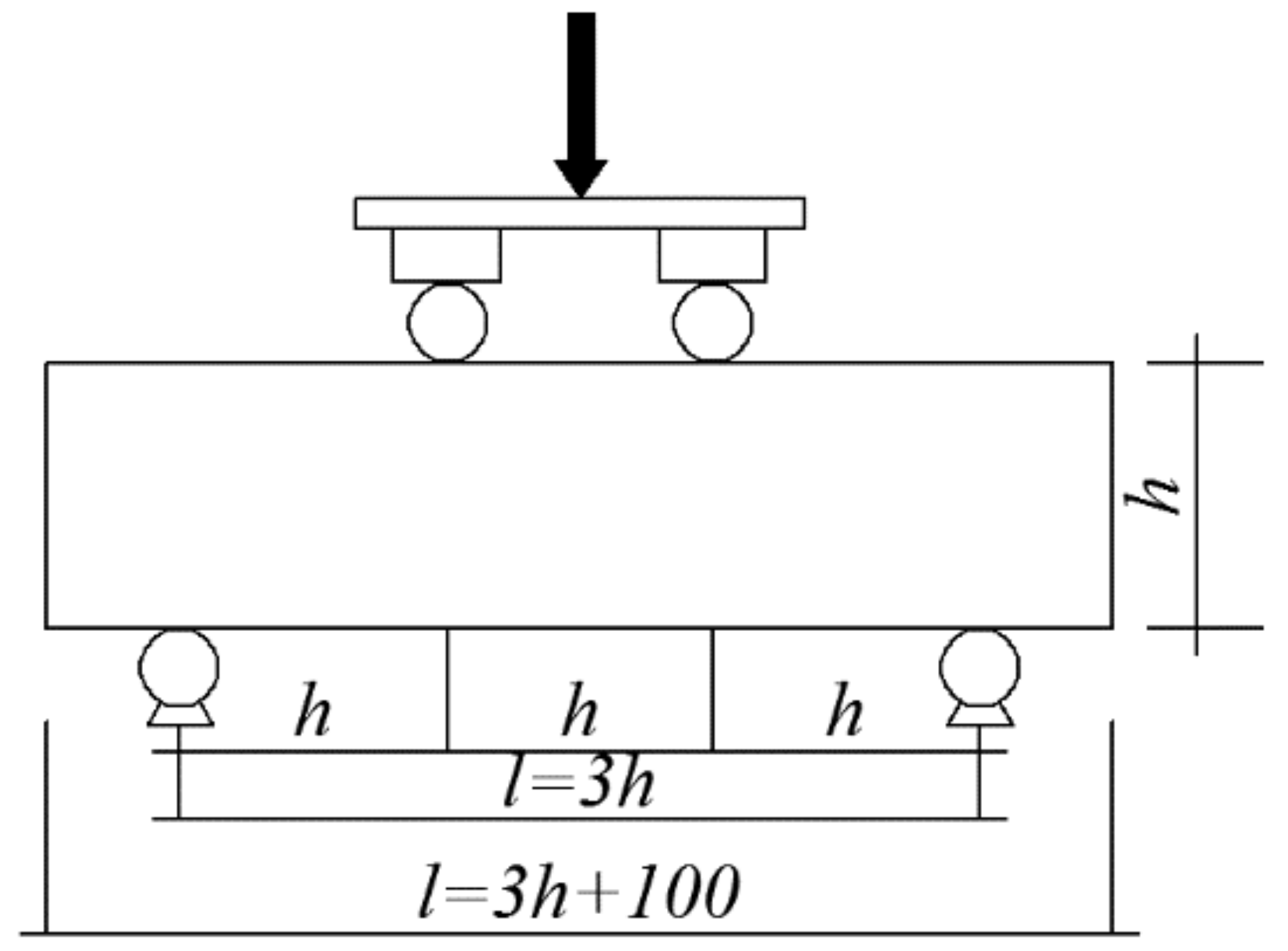
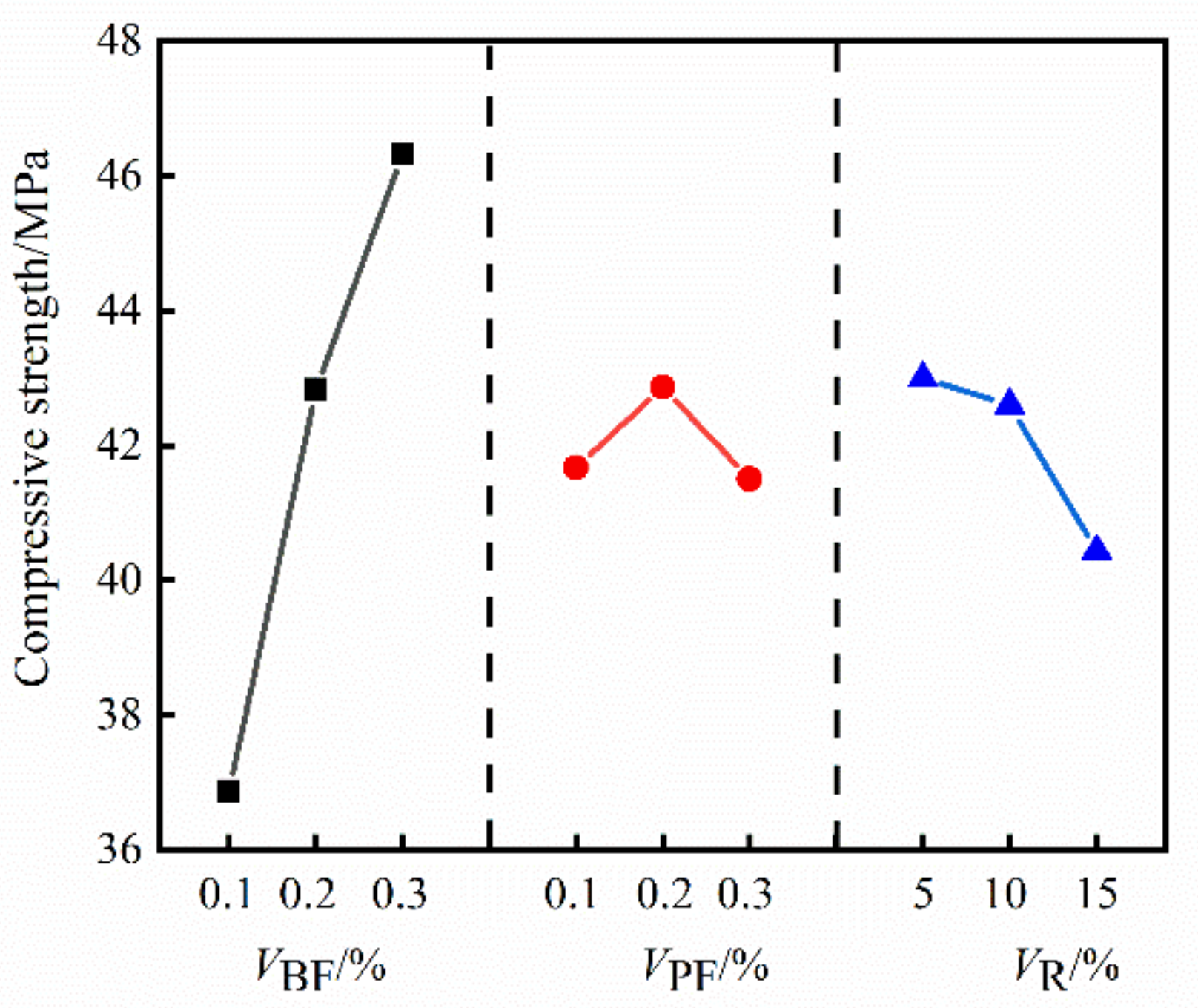
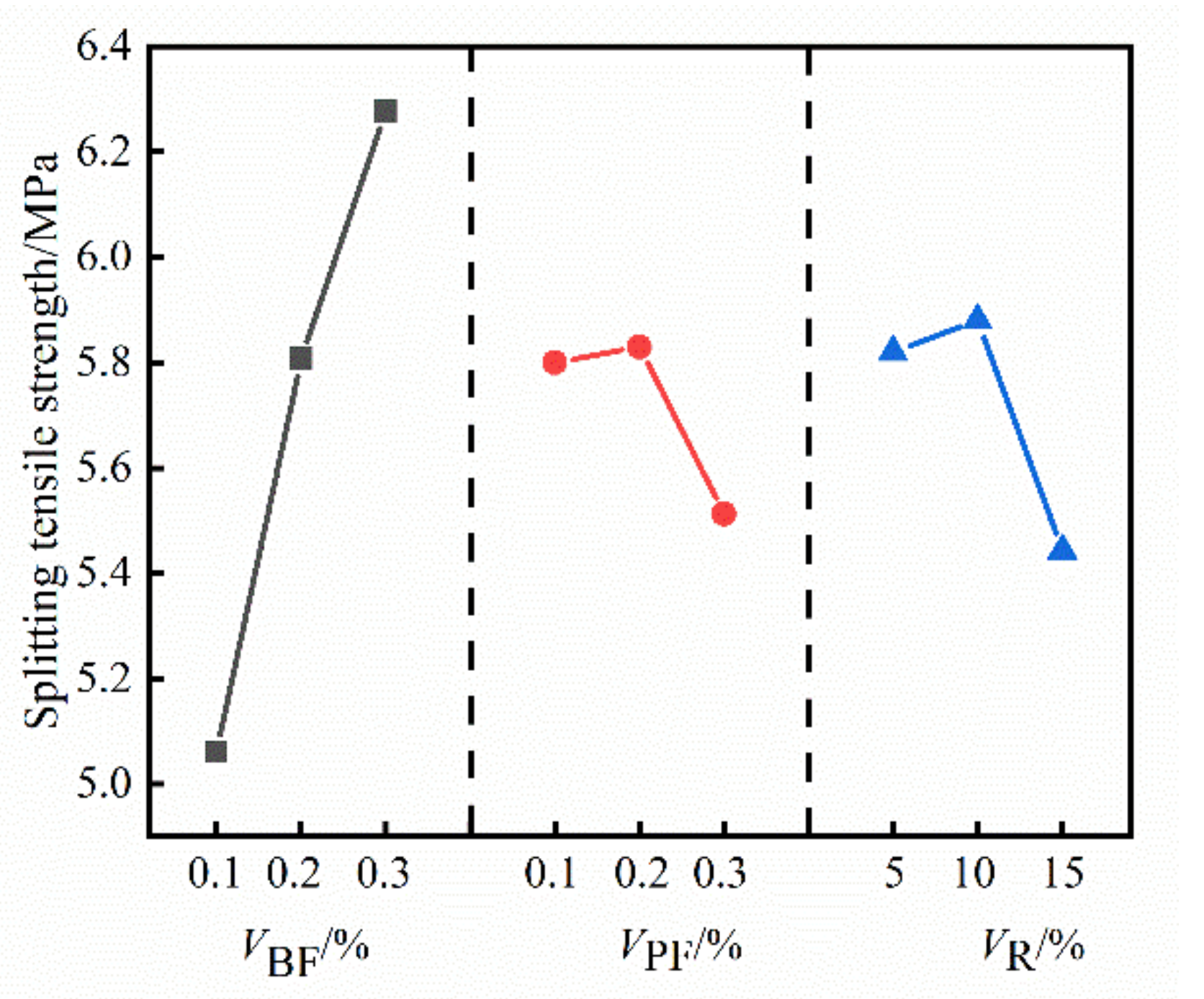
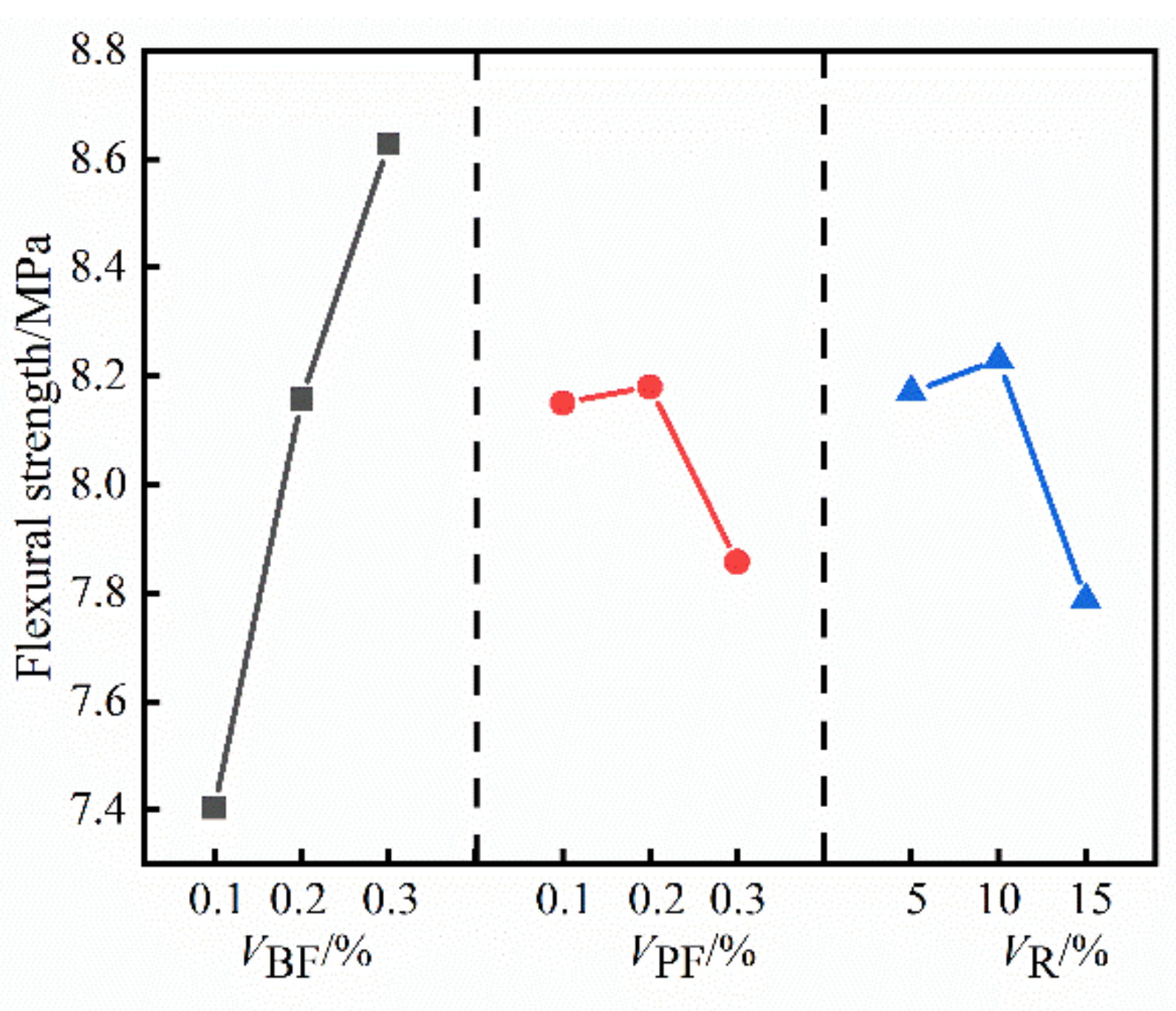
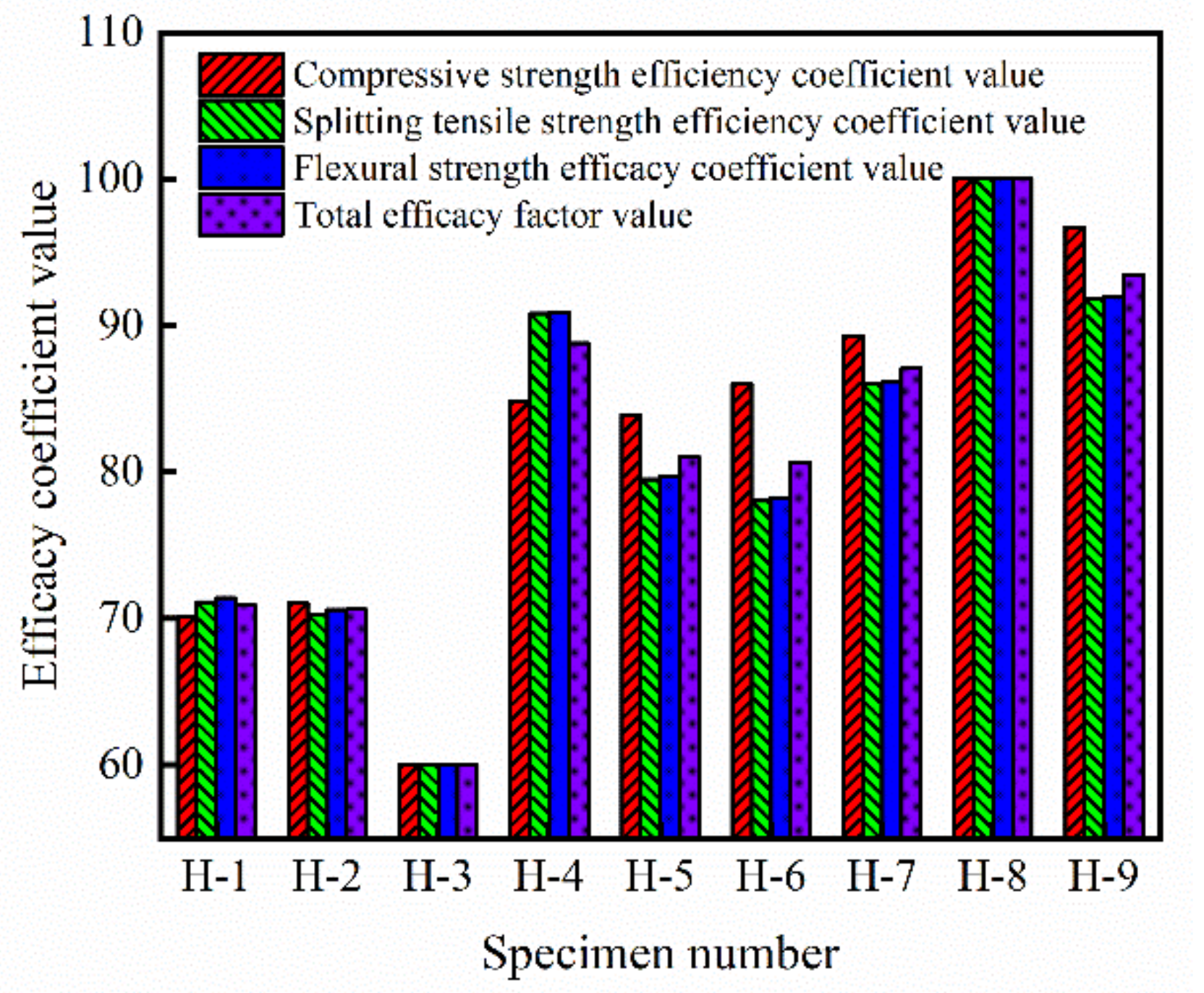

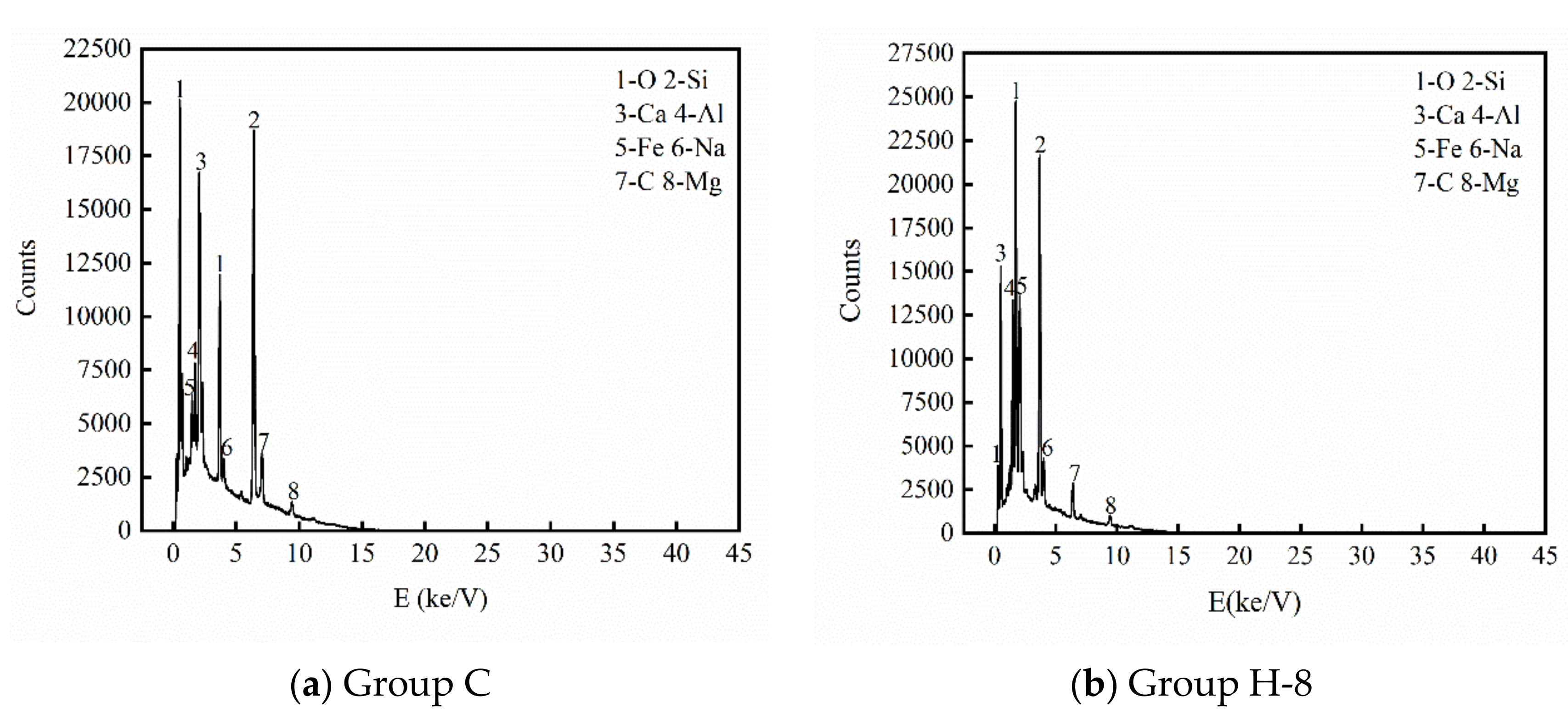
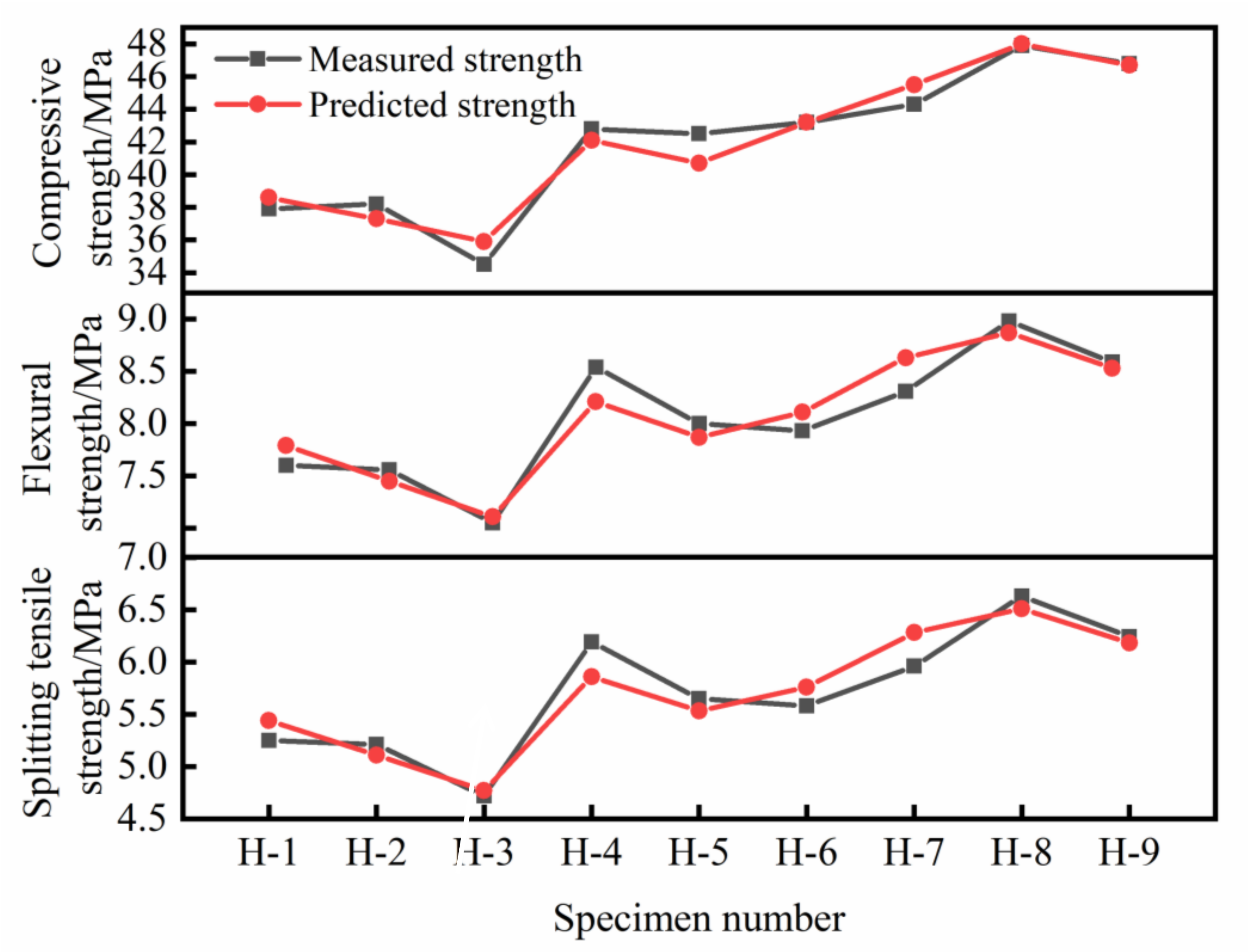
| Fiber | Basalt Fiber | PVA Fiber |
|---|---|---|
| Tensile strength/MPa | 3500 | 600 |
| Modulus of elasticity/GPa | 100 | 5.75 |
| Density/(g/cm3) | 2.8 | 0.91 |
| Diameter/µm | 12 | 8 |
| Length/mm | 18 | 12 |
| Elongation at break/% | 3.2 | 16 |
| Level | Factor | ||
|---|---|---|---|
| VBF/(%) | VPF/(%) | VR/(%) | |
| 1 | 0.1 | 0.1 | 5 |
| 2 | 0.2 | 0.2 | 10 |
| 3 | 0.3 | 0.3 | 15 |
| Specimen Number | Cement | Coarse Aggregate | Fine Aggregate | Basalt Fiber | PVA Fiber | Rubber | Water | Water-Reducing Agent |
|---|---|---|---|---|---|---|---|---|
| C | 465 | 1242 | 600 | 0 | 0 | 0 | 155 | 5.15 |
| H-1 | 465 | 1242 | 600 | 2.8 | 0.91 | 52.5 | 155 | 5.15 |
| H-2 | 465 | 1242 | 600 | 2.8 | 1.82 | 105 | 155 | 5.15 |
| H-3 | 465 | 1242 | 600 | 2.8 | 2.73 | 157.5 | 155 | 5.15 |
| H-4 | 465 | 1242 | 600 | 5.6 | 0.91 | 105 | 155 | 5.15 |
| H-5 | 465 | 1242 | 600 | 5.6 | 1.82 | 157.5 | 155 | 5.15 |
| H-6 | 465 | 1242 | 600 | 5.6 | 2.73 | 52.5 | 155 | 5.15 |
| H-7 | 465 | 1242 | 600 | 8.4 | 0.91 | 157.5 | 155 | 5.15 |
| H-8 | 465 | 1242 | 600 | 8.4 | 1.82 | 52.5 | 155 | 5.15 |
| H-9 | 465 | 1242 | 600 | 8.4 | 2.73 | 105 | 155 | 5.15 |
| Specimen Number | Compressive Strength /MPa | Splitting Tensile Strength /MPa | Flexural Strength /MPa |
|---|---|---|---|
| C | 34.2 | 4.65 | 6.54 |
| H-1 | 37.9 | 5.25 | 7.6 |
| H-2 | 38.2 | 5.21 | 7.56 |
| H-3 | 34.5 | 4.72 | 7.05 |
| H-4 | 42.8 | 6.19 | 8.54 |
| H-5 | 42.5 | 5.65 | 8.0 |
| H-6 | 43.2 | 5.58 | 7.93 |
| H-7 | 44.3 | 5.96 | 8.31 |
| H-8 | 47.9 | 6.63 | 8.98 |
| H-9 | 46.8 | 6.24 | 8.59 |
| Factor | Compressive Strength | Splitting Tensile Strength | Flexural Strength | ||||||
|---|---|---|---|---|---|---|---|---|---|
| VBF | VPF | VR | VBF | VPF | VR | VBF | VPF | VR | |
| R | 9.47 | 1.37 | 2.57 | 1.217 | 0.317 | 0.437 | 1.223 | 0.323 | 0.443 |
| Index | Factor | Sum of Squares | Mean Square | Freedom | F value | Significance |
|---|---|---|---|---|---|---|
| Compressive strength/MPa | A | 137.47 | 68.73 | 2 | 190.34 | ** |
| B | 3.34 | 1.67 | 2 | 4.62 | ⦿ | |
| C | 11.44 | 5.72 | 2 | 15.84 | * | |
| E | 0.72 | 0.36 | 2 | |||
| Splitting tensile strength/MP | A | 2.26 | 1.13 | 2 | 27.71 | ** |
| B | 0.18 | 0.09 | 2 | 1.76 | _ | |
| C | 0.34 | 0.17 | 2 | 3.23 | ⦿ | |
| E | 0.1 | 0.05 | 2 | |||
| Flexural strength/MPa | A | 2.28 | 1.14 | 2 | 23.12 | ** |
| B | 0.19 | 0.1 | 2 | 1.94 | _ | |
| C | 0.35 | 0.17 | 2 | 3.51 | ⦿ | |
| E | 0.1 | 0.05 | 2 |
| Value Type | Compressive Strength /MPa | Splitting Tensile Strength/ MPa | Flexural Strength /MPa |
|---|---|---|---|
| Satisfactory value | 47.9 | 6.63 | 8.98 |
| Unsatisfactory value | 34.5 | 4.72 | 7.05 |
| Element | Group C | Group H-8 | ||
|---|---|---|---|---|
| Mass Content /% | Atomic Content /% | Mass Content /% | Atomic Content /% | |
| O | 33.67 | 50.49 | 46.68 | 62.65 |
| Si | 12.71 | 10.86 | 23.25 | 17.77 |
| Ca | 26.7 | 15.98 | 19.94 | 10.68 |
| Al | 6.32 | 5.61 | 4.39 | 3.49 |
| Fe | 7.79 | 3.34 | 1.75 | 0.67 |
| Na | 0.72 | 0.75 | 1.01 | 0.95 |
| C | 3.11 | 6.21 | 1.55 | 2.77 |
| Mg | 0.85 | 0.84 | 0.72 | 0.64 |
Publisher’s Note: MDPI stays neutral with regard to jurisdictional claims in published maps and institutional affiliations. |
© 2021 by the authors. Licensee MDPI, Basel, Switzerland. This article is an open access article distributed under the terms and conditions of the Creative Commons Attribution (CC BY) license (https://creativecommons.org/licenses/by/4.0/).
Share and Cite
Su, Q.; Xu, J.-M.; Wang, Y.-D. Mechanical Properties of Hybrid Fiber Reinforced Rubber Concrete. Materials 2021, 14, 6028. https://doi.org/10.3390/ma14206028
Su Q, Xu J-M, Wang Y-D. Mechanical Properties of Hybrid Fiber Reinforced Rubber Concrete. Materials. 2021; 14(20):6028. https://doi.org/10.3390/ma14206028
Chicago/Turabian StyleSu, Qiang, Jin-Ming Xu, and Yong-Dong Wang. 2021. "Mechanical Properties of Hybrid Fiber Reinforced Rubber Concrete" Materials 14, no. 20: 6028. https://doi.org/10.3390/ma14206028





